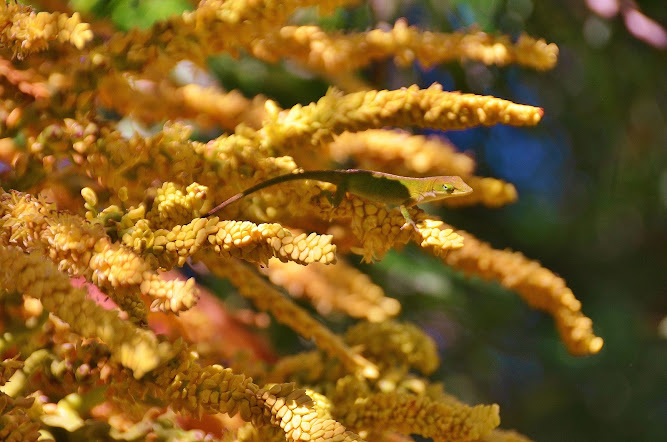The Biggest Surprise in My Wildlife Garden Was Also One of the Smallest
During the Pandemic, I hunkered down and decided to expand my little outside corner of the planet into something that could keep my hands and mind occupied but away from the stresses plaguing us all. I dug in, literally and studied and perfected a wildlife garden that to this day provides a wonderful and rewarding respite. In my efforts, I discovered a rather surprising and heretofore unrecognized gem in the world of wildlife gardening. Palm trees of all things, especially the flowering Jelly Palms add a lot more than beauty and atmosphere to your landscape. The stately palm remains beautiful but also stays the same through most of the year, including the cold months in the deep south. Suddenly however, sometime in Spring or Summer-depending on the particular species, a long pod develops on this particular palm, and then slowly begins drooping toward the ground. After a short time, this 3ish foot long pod will suddenly pop open to reveal this beautiful spray of intriguing tiny blossoms. During that time, they develop and attract a wide variety of pollinators necessary to your wildlife garden.
The soft pink inside the pod appears at a strategic time and reminds me of a conch shell but is only available to shoot for a very small window. I loved this shot, because the weather cooperated and I could capture a Carolina Anole showcased by a realm of colors. I captured a bit of the fleeting pink inside, and just enough of a blue sky and deep green tree to provide a uniquely beautiful background to the pale blossoms. Anoles love this special time of year in the palms, and nap, sun and hunt on the flower sprays, as other pollinators dart from blossom to blossom.
This anole was waiting patiently for lunch and turned the appropriate colors to camouflage himself. This shot seemed to encapsulate the best and most surprising that Mother Nature could offer in my wildlife garden on this otherwise ordinary and sultry Carolina day.
.JPG)
After they're pollinated, blossoms turn into fruit that is naturally tangy and ultimately develops a crunchy shell outside that is like the cherry on a sunday for squirrels. For the weeks that the fruit ripens, you hear the constant and contented "crunch, crunch, crunch" of squirrels camping out in your palms. The fruit is naturally high in pectin and foodies have gathered it to make jelly, ice cream topping, and wine. Thus, the coined name, Jelly Palms. Fair warning if you decide to experiment, however. You should cut down the spray before it is completely ripe and the fruit falls.
Then bring it inside and hang it in a sunny window to finish ripening and to dry to protect it from your worthy competitors, like insects, squirrels, and mold. The fruit molds quickly and won't ripen at the same time, so put the batches of the hard, ripened fruit in the freezer as soon as they drop off until you have enough for your recipe.
There are different species of these particular palms and it's fun to plant a variety of them, making sure there's enough for yourself and your wild friends. Whether your fruit is a paler yellow or a deeper rust, all are tasty. Foodies have described the fruit in a variety of flavors, some like a citrus banana combo, some with pineapple hints, depending on your particular varieties, which also have different colors.
I never realized palms bloomed so of all the plants I included in my southern wildlife garden; this was the most surprising as far as its contribution and the number of pollinators it surprisingly attracted.
Happy gardening for your local wildlife!

.jpg)

.jpg)


Comments